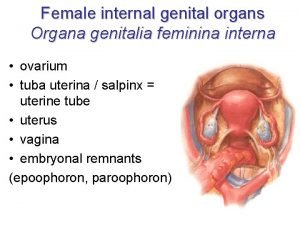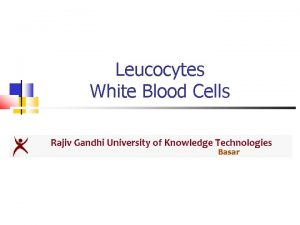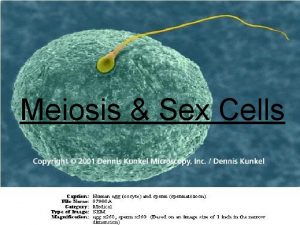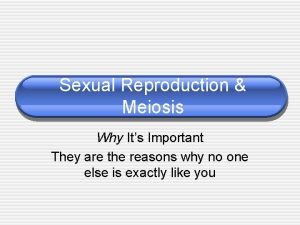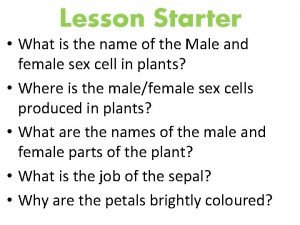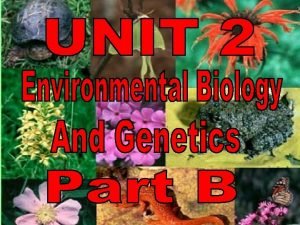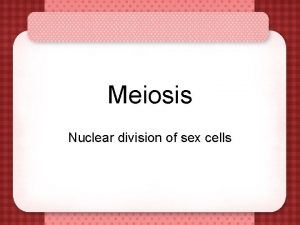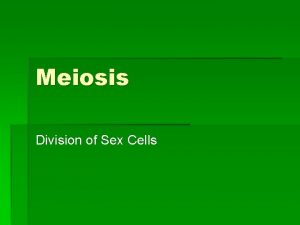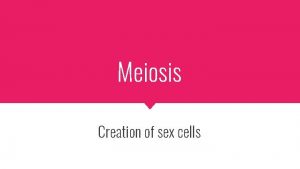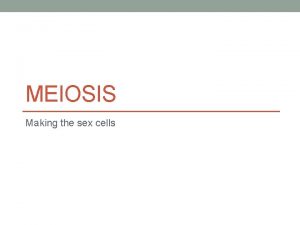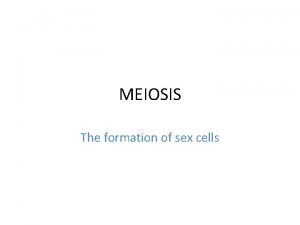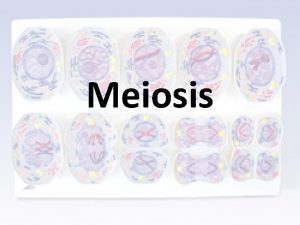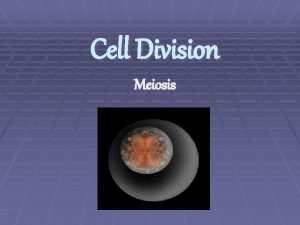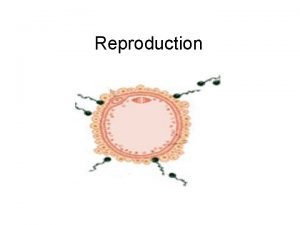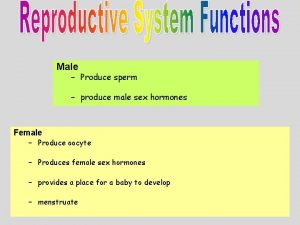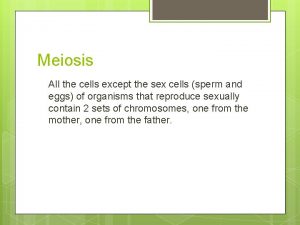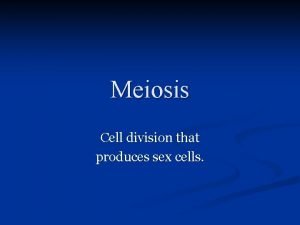Meiosis Division to produce Sex Cells Meiosis A


















- Slides: 18

Meiosis Division to produce Sex Cells

Meiosis§ A process of cell division in which a diploid cell produces haploid gametes by separating homologous pairs of chromosomes. § Diploid – 2 sets of chromosomes § Haploid – 1 set of chromosomes § Gamete – sex cells, (sperm, egg, pollen, ovum) § Homologous – pairs of matching chromosomes that come from each parent (numbered 1 -23 in humans)


Meiosis

Meiosis Stages § Meiosis involves 2 distinct cell divisions: § Meiosis I § (P, M, A, T) § Meiosis II § (P, M, A, T) Meiosis Animation

Prophase I § Each chromosome pairs with its corresponding homologous chromosome to form a tetrad. § There are 4 chromosomes in a tetrad (2 pairs of sister chromatids) § The pairing of homologous chromosomes is the key to meiosis. § Crossing-over may occur here § Crossing-over is when chromosomes overlap and exchange portions of their DNA (genes) “CROSSING OVER” is like “shuffling the genetic deck”- called RECOMBINATION

Prophase I

Metaphase I § Homologous pairs line up side by side in middle of cell § It is RANDOM which side the maternal and paternal chromosomes line up on “RANDOM ASSORTMENT” is a second “shuffling of the genetic deck”

Anaphase I § Homologous pairs pulled apart. (Not sister chromatids!!)

Telophase I & Cytokinesis § Nuclear membranes form. § The cell separates into 2 HAPLOID cells.

End of Meiosis I § Meiosis I results in two haploid (1 N) cells. § Each cell has half the number of chromosomes as the original cell. Meiosis II § Starts immediately after Meiosis I (no interphase) § Meiosis II is basically just like Mitosis

Prophase II § Chromosomes re-condense and nuclear membrane breaks down again (similar to Prophase of Mitosis)

Metaphase II § The chromosomes line up similar to metaphase in mitosis.

Anaphase II § Sister chromatids separate and move to opposite sides.

Telophase II and Cytokinesis § Meiosis II results in 4 GENETICALLY DIFFERENT haploid cells. (gametes)

Gamete Formation § In males, meiosis results in 4 sperm cells (spermatogenesis)

Gamete Formation § In females, meiosis results in 1 egg cell and three polar bodies, which are not used in reproduction. (Oogenesis)

Mitosis vs Meiosis Results in Cells are Occurs in Mitosis 2 Diploid Cells (2 N) Genetically Identical Somatic (Body) Cells Meiosis 4 Haploid Cells (N) Genetically Different Sex Cells
 Sex sex sex
Sex sex sex Secondary sexual characters
Secondary sexual characters Snv sex
Snv sex Sex sex sex
Sex sex sex Sex sex sex
Sex sex sex Does meiosis 1 produce haploid cells
Does meiosis 1 produce haploid cells Sex determination and sex linkage
Sex determination and sex linkage Once a sex offender always a sex offender
Once a sex offender always a sex offender Punnett square for sex linked traits
Punnett square for sex linked traits Sex determination and sex linkage
Sex determination and sex linkage Organa genitalia feminina nedir
Organa genitalia feminina nedir White blood cells produce antibodies
White blood cells produce antibodies Two types of wbc
Two types of wbc Cells produce atp most efficiently in the presence of *
Cells produce atp most efficiently in the presence of * Cells
Cells Sex cells
Sex cells How many chromosomes are in a human’s sex cells?
How many chromosomes are in a human’s sex cells? Plant sex cells
Plant sex cells Epididimis berfungsi
Epididimis berfungsi










